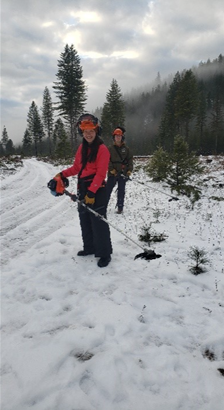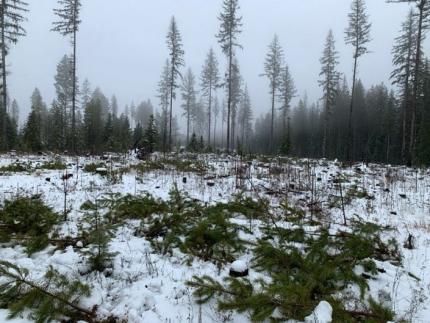Managing Wildlife Populations
Bear Trap Removal: Wildlife Biologist Prince removed a bear trap that was set up over the weekend in an effort to trap an orphaned bear discovered by a local resident. The bear cub was feeding on and bedding underneath a deer carcass outside of Metaline Falls. Unfortunately, the bear was not seen on camera or captured.
Sharp-tailed Grouse: Biologists Lowe and Brinkman attended a planning meeting with staff members that will be involved in translocating sharp-tailed grouse from British Columbia to Washington in the spring.
Grouse and Shrubsteppe Songbird Species Lead Atamian demonstrated the process of attaching netting to sharp-tailed grouse funnels for walk-in traps so that Biologists Lowe and Brinkman can assist with preparing traps for the capture effort in British Columbia.

Providing Conflict Prevention and Education
Spokane Moose: Wildlife Conflict Specialist Harris responded to a report of a cow moose that has been stuck inside a fenced property since Christmas. The property is 50 acres of forested land that is surrounded by 6-foot-tall chain link fencing. Harris and the reporting party attempted to herd the moose towards an open gate without success. The moose appears to be in good health and has adequate access to food and water on the property. Washington Department of Fish and Wildlife staff members will continue to monitor the situation.

Conserving Natural Landscapes
Timber Management: For a third week in a row, Sherman Creek Wildlife Area Assistant Manager Palmer spent two days at LeClerc Creek Wildlife Area. He used a pole-style brush cutter to remove undesirable lodgepole pines from regrowth areas that had been previously thinned. On Tuesday, he had volunteer help from Access Manager Dziekan, Conflict Specialist Harris, and Private Lands Biologist Baarstad. Wednesday, he was assisted by Washington Department of Fish and Wildlife Research Scientist DeVivo, Lands Agent Stallinga, and Biologist Westacott. Over just two days of work, Palmer and his crews cleaned up 28.5 acres of land. Thanks to all the volunteers who showed up to lend a hand!






Prescribed Burn Planning: Private Lands Biologist Nizer is in the planning process for a prescribed burn on a property enrolled in the Hunt by Reservation Program. Nizer reached out to Department of Ecology for permits regarding the burn.

Conducting Business Operations and Policy
New Rock Rake: This week, Wildlife Area Manager Finch and Wildlife Area Assistant Manager Rimmelspacher worked on blading the one-mile entry road coming into the office complex. After the rain the following day, Finch and Rimmelspacher tried out the new rock rake for the first time. The new rock rake did an excellent job on the road, and it may take the place of grading the road at certain times and conditions.


Other
Cultural Resource Survey: Archeologist Davis visited the W.T. Wooten Wildlife Area this week to dig the holes for a cultural resources survey on the site where a new pole building will be built at the Wooten headquarters. Wooten staff members assisted with digging the survey holes. While the archeologist was on site, he dug a couple test holes where the new irrigation well will be drilled to save Capital Asset Management Program staff members from having to come back to the site for an additional survey.
